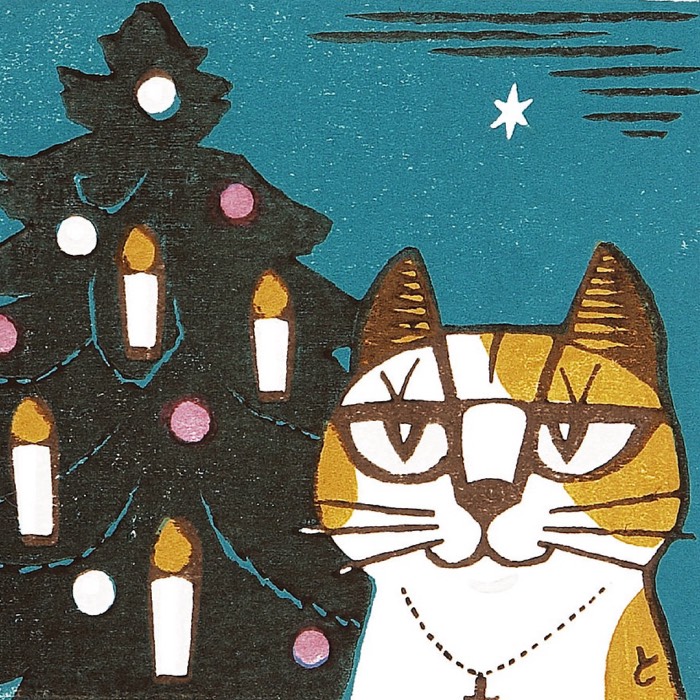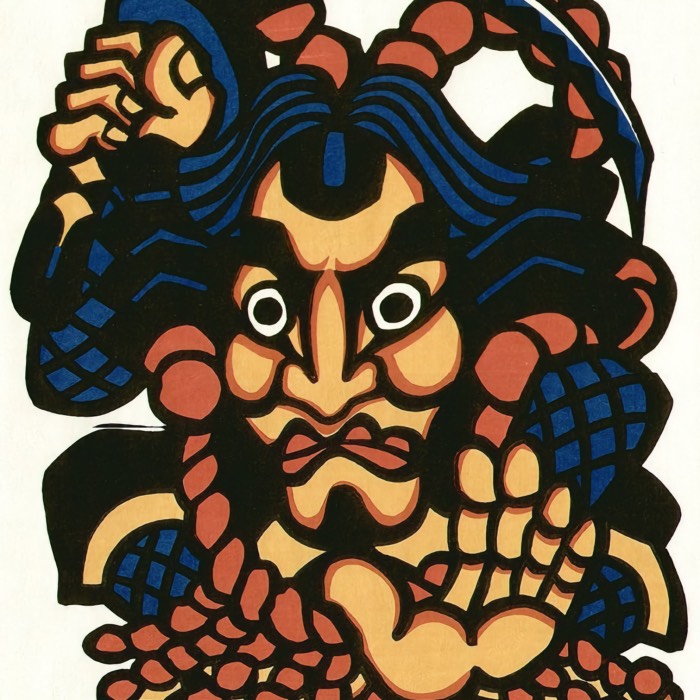Ohara Koson: Master of kacho-e
Among the most famous Shin Hanga artist, Ohara Koson is celebrated for his exquisite kacho-e prints, which depict birds, flowers, and other elements of nature with a delicate and refined touch. His work is characterized by a meticulous attention to detail, a deep sensitivity to the beauty of the natural world, and a mastery of color and composition.
 Heron in the Rain, Ohara Koson, 1928. Source: ukiyo-e.orgꜛ
Heron in the Rain, Ohara Koson, 1928. Source: ukiyo-e.orgꜛ
Biography
Ohara Koson (小原 古邨), also known as Ohara Shōson and Ohara Hōson, was born on February 9, 1877, in Kanazawa, Ishikawa Prefecture, Japan. Koson is widely recognized as one of the foremost artists of the Shin Hanga movement, particularly known for his exquisite kacho-e (bird-and-flower prints). His work is celebrated for its delicate beauty and the masterful portrayal of wildlife, which has made him one of the most beloved and collectible artists of the early 20th century.

Ohara Koson, around the age of 53. Source: Wikimedia Commonsꜛ (license: public domain)
Koson began his artistic training in Kanazawa, studying Nihonga (traditional Japanese painting) under the tutelage of Suzuki Kason, a well-respected painter of the time. Under Kason’s guidance, Koson developed a deep appreciation for the traditional Japanese aesthetic, particularly the subtle beauty found in nature. This early training laid the foundation for Koson’s later work as a master of kacho-e.
In the early 20th century, Koson moved to Tokyo, where he became involved in the Shin Hanga movement. His talent for depicting birds, flowers, and other elements of nature quickly attracted the attention of Watanabe Shōzaburō, the influential publisher who played a pivotal role in the revival of traditional woodblock printing through Shin Hanga. Under Watanabe’s direction, Koson produced a prolific body of work that was highly popular both in Japan and internationally, particularly in the United States.
Koson’s prints were admired for their elegance, precision, and the way they captured the essence of the natural world. His works were especially popular with Western collectors, who were drawn to the serene beauty and technical mastery of his prints. Despite the challenges faced by Japanese artists during the turbulent years of the early 20th century, Koson’s work remained in high demand, and he continued to produce prints until his death on January 13, 1945.
Artistic style and significance
Ohara Koson is best known for his kacho-e prints, which depict birds, flowers, and other elements of nature with a delicate and refined touch. His work is characterized by a meticulous attention to detail, a deep sensitivity to the beauty of the natural world, and a mastery of color and composition.
Kacho-e: A celebration of nature’s beauty
Koson’s kacho-e prints are celebrated for their ability to capture the grace and elegance of birds and flowers with remarkable precision. His work often features a single bird or flower, carefully rendered against a simple, uncluttered background. This minimalist approach allows the viewer to focus entirely on the subject, appreciating the intricate details and the harmony of form and color.


Left: Two Cockatoos on Plum Blossom Tree, Ohara Koson, c. 1925–1935. Source: Wikimedia Commonsꜛ (license: public domain) – Right: Cat and Bowl of Goldfish, Ohara Koson, 1933. Source: Wikimedia Commonsꜛ (license: public domain)
Koson’s birds are depicted with an extraordinary level of realism, yet they are also imbued with a sense of personality and life. Whether portraying a solitary heron standing in a misty marsh or a pair of sparrows perched on a branch, Koson’s prints convey a sense of tranquility and harmony with nature. His flowers, too, are rendered with great care, often highlighting the delicate textures and subtle colors that make each bloom unique.


Left: Scops Owl, Cherry Blossoms, and Moon, Ohara Koson, 1926. Source: Wikimedia Commonsꜛ (license: public domain) – Right: Heron at full moon, Ohara Koson, 1950. Source: Wikimedia Commonsꜛ (license: public domain)
Mastery of color and composition
One of the defining characteristics of Koson’s work is his mastery of color and composition. His use of color is both subtle and expressive, often employing a limited palette to create a sense of depth and atmosphere. The careful gradation of tones, combined with the precise placement of each element within the composition, gives his prints a sense of balance and harmony that is both pleasing to the eye and emotionally evocative.


Left: Pheasant, Ohara Koson, 1950. Source: Wikimedia Commonsꜛ (license: public domain) – Right: Bird and persimmon fruit, Ohara Koson, 1950. Source: Wikimedia Commonsꜛ (license: public domain)
Koson’s ability to capture the changing seasons through his choice of subjects and colors is particularly noteworthy. His prints often reflect the cyclical nature of life, with each bird and flower representing a specific moment in time. This focus on the fleeting beauty of nature is a central theme in Koson’s work, making his prints not only visually stunning but also deeply resonant on an emotional level.
Influence and legacy
Koson’s contribution to the Shin Hanga movement was significant, particularly in the genre of kacho-e. His work helped to revive and popularize this traditional form of Japanese art, making it accessible to both Japanese and Western audiences. The beauty and craftsmanship of his prints were widely recognized, and his work remains highly valued by collectors around the world.
In addition to his impact on the Shin Hanga movement, Koson’s influence can also be seen in the work of later artists who sought to capture the beauty of nature with the same level of precision and sensitivity. His prints continue to be celebrated for their elegance, technical mastery, and their ability to evoke a deep appreciation for the natural world.
 Boats, Ohara Koson, 1950. Source: Wikimedia Commonsꜛ (license: public domain)
Boats, Ohara Koson, 1950. Source: Wikimedia Commonsꜛ (license: public domain)
Notable works
Throughout his career, Ohara Koson produced a vast number of prints, many of which are considered masterpieces of the Shin Hanga movement. Here are some of his most famous works:
 Two Mallard Ducks and the Moon, Ohara Koson, early 20th c. Source: ukiyo-e.orgꜛ
Two Mallard Ducks and the Moon, Ohara Koson, early 20th c. Source: ukiyo-e.orgꜛ


Left: Monkey and Moon, Ohara Koson, ca. 1900-1920. Source: ukiyo-e.orgꜛ – Right: Blue Irises, Ohara Koson. Source: Wikimedia Commonsꜛ (license: public domain)


Left: Parrots, Ohara Koson, 1945. Source: Wikimedia Commonsꜛ (license: public domain) – Right: Willow Bridge, Yanagibashi, Ohara Koson, 1927. Source: ukiyo-e.orgꜛ


Left: Two Monkeys and Butterflies, Ohara Koson, 1936. Source: ukiyo-e.orgꜛ – Right: Beo on flowering magnolia branch, Oahara Kason, 1950. Source: Wikimedia Commonsꜛ (license: public domain)


Left: Crow on a Snow Covered Branch (pink variant), Ohara Koson, 1930s. Source: Wikimedia Commonsꜛ (license: public domain) – Right: Crow on a Snow Covered Branch (orange variant), Ohara Koson, 1930s. Source: ukiyo-e.orgꜛ


Left: Cockatoo on Pomegranate Branch, Ohara Koson, 1927. Source: Wikimedia Commonsꜛ (license: public domain) – Right: White Chinese Geese Swimming by Reeds, Ohara Koson, 1926. Source: Wikimedia Commonsꜛ (license: public domain)
 Mallard and Lotus, Ohara Koson, 1936. Source: ukiyo-e.orgꜛ
Mallard and Lotus, Ohara Koson, 1936. Source: ukiyo-e.orgꜛ
 Two Carp and Water Lily Pad, Ohara Koson, 1933. Source: ukiyo-e.orgꜛ
Two Carp and Water Lily Pad, Ohara Koson, 1933. Source: ukiyo-e.orgꜛ


Left: Siberian Blue Nightingale near a peony under a snowy sheaf, Ohara Koson, c.1925-c.1936. Source: Wikimedia Commonsꜛ (license: public domain) – Right: Crow and Blossom, Ohara Koson, c. 1910. Source: Wikimedia Commonsꜛ (license: public domain)


Left: Cawing crow, Ohara Koson, c. 1900s. Source: Wikimedia Commonsꜛ (license: public domain) – Right: Three white mice, Ohara Koson, 1950. Source: Wikimedia Commonsꜛ (license: public domain)


Left: Monkey on the tree, Ohara Koson, 1950. Source: Wikimedia Commonsꜛ (license: public domain) – Right: Monkey with her child, Ohara Koson, 1950. Source: Wikimedia Commonsꜛ (license: public domain)
 Sumō-wrestling toads, Ohara Koson, c. 1930. Source: Wikimedia Commonsꜛ (license: public domain)
Sumō-wrestling toads, Ohara Koson, c. 1930. Source: Wikimedia Commonsꜛ (license: public domain)


Left: A man harvesting ginkgo nuts, Ohara Koson. Source: Wikimedia Commonsꜛ (license: public domain) – Right: Ashi ni shigi, Ohara Koson. Source: Wikimedia Commonsꜛ (license: public domain)


Left: Crow and blossom, Ohara Koson, 1910. Source: Wikimedia Commonsꜛ (license: public domain) – Right: Pheasant, Ohara Koson. Source: Wikimedia Commonsꜛ (license: public domain)


Left: Hanashōbu, Ohara Koson, 1900. Source: Wikimedia Commonsꜛ (license: public domain) – Right: Hawk, Ohara Koson. Source: Wikimedia Commonsꜛ (license: CC0 1.0 public domain)
 Kingfisher, Ohara Koson, c. 1920. Source: Wikimedia Commonsꜛ (license: public domain)
Kingfisher, Ohara Koson, c. 1920. Source: Wikimedia Commonsꜛ (license: public domain)


Left: Carps, Ohara Koson. Source: Wikimedia Commonsꜛ (license: public domain) – Right: Flock of Geese, Ohara Koson, 1926. Source: ukiyo-e.orgꜛ


Left: Monkey, Ohara Koson, 1930s. Source: ukiyo-e.orgꜛ – Right: Ligularia, Ohara Koson, 1930s. Source: ukiyo-e.orgꜛ


Left: Flowering Lotus, Ohara Koson, 1930s. Source: ukiyo-e.orgꜛ – Right: Canary and Roses, Ohara Koson. Source: ukiyo-e.orgꜛ


Left: Grouchy Rabbits, Ohara Koson, 1930s. Source: ukiyo-e.orgꜛ – Right: Two Goldfish, Ohara Koson, 1910. Source: ukiyo-e.orgꜛ


Left: Monkey, Wasp and Persimmons, Ohara Koson, 1935. Source: ukiyo-e.orgꜛ – Right: Dancing Fox, Ohara Koson, c. 1910s. Source: ukiyo-e.orgꜛ
 Wading Egret, Ohara Koson, 1910s. Source: ukiyo-e.orgꜛ
Wading Egret, Ohara Koson, 1910s. Source: ukiyo-e.orgꜛ
 Two Gold Fish, Ohara Koson, 1910s. Source: ukiyo-e.orgꜛ
Two Gold Fish, Ohara Koson, 1910s. Source: ukiyo-e.orgꜛ
 Snowy Landscape, Ohara Koson, c. 1930s. Source: ukiyo-e.orgꜛ
Snowy Landscape, Ohara Koson, c. 1930s. Source: ukiyo-e.orgꜛ
 Kingfisher, Ohara Koson, 1935. Source: ukiyo-e.orgꜛ
Kingfisher, Ohara Koson, 1935. Source: ukiyo-e.orgꜛ
 Two Swans, Ohara Koson, 1928. Source: ukiyo-e.orgꜛ
Two Swans, Ohara Koson, 1928. Source: ukiyo-e.orgꜛ


Left: Crow on a Snowy Bough, Ohara Koson, ca. 1900-10. Source: ukiyo-e.orgꜛ – Right: Cranes on Seashore, Ohara Koson, 1933. Source: ukiyo-e.orgꜛ
 Deer, stone lantern and Torii, Ohara Koson, c. 1900. Source: ukiyo-e.orgꜛ
Deer, stone lantern and Torii, Ohara Koson, c. 1900. Source: ukiyo-e.orgꜛ
 Deer in Shallow Water, Ohara Koson, 1936. Source: ukiyo-e.orgꜛ
Deer in Shallow Water, Ohara Koson, 1936. Source: ukiyo-e.orgꜛ


Left: Two Geese, Ohara Koson, 1910. Source: ukiyo-e.orgꜛ – Right: Two Egrets and Willow Tree, Ohara Koson, 1926. Source: ukiyo-e.orgꜛ
 Leaping Carp, Ohara Koson, 1935. Source: ukiyo-e.orgꜛ
Leaping Carp, Ohara Koson, 1935. Source: ukiyo-e.orgꜛ


Left: Bar-tailed Godwits, Ohara Koson, 1926. Source: ukiyo-e.orgꜛ – Right: Two Egrets at Night, Ohara Koson, c. 1910. Source: ukiyo-e.orgꜛ


Left: Cat, Ohara Koson, 1930. Source: Wikimedia Commonsꜛ (license: public domain) – Right: Deer, Ohara Koson, 1945. Source: Wikimedia Commonsꜛ (license: public domain)

Plum before moon, Ohara Koson, 1945. Source: Wikimedia Commonsꜛ (license: public domain)
Conclusion
Ohara Koson is remembered as one of the most significant and beloved artists of the Shin Hanga movement, particularly for his contributions to the genre of kacho-e. His prints, which capture the delicate beauty of birds, flowers, and other elements of nature with extraordinary precision and grace, have earned him a lasting place in the history of Japanese art. Koson’s ability to evoke the tranquility and harmony of the natural world continues to resonate with viewers, making his work highly valued by collectors and art enthusiasts around the world. His legacy as a master of kacho-e ensures that his prints will be cherished for generations to come.
References and further reading
- Chris Uhlenbeck, Jim Dwinger, Philo Ouweleen, Shin Hanga - Die »Neuen Drucke« Japans 1900-1950, 2022, Hatje Cantz, ISBN: 9783775752190
- viewingjapaneseprints.netꜛ
- Ohara Koson on ukioy-e.orgꜛ










comments